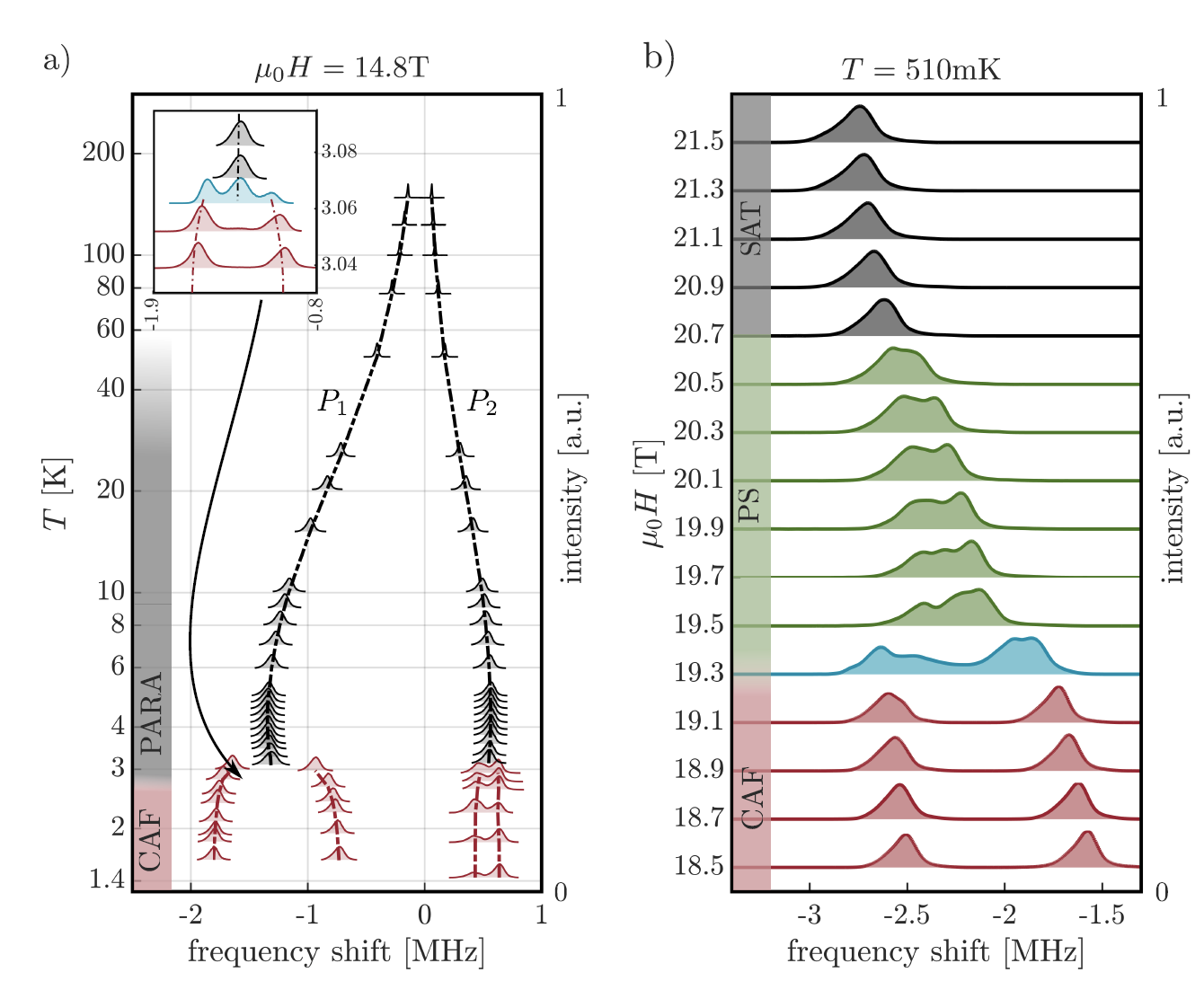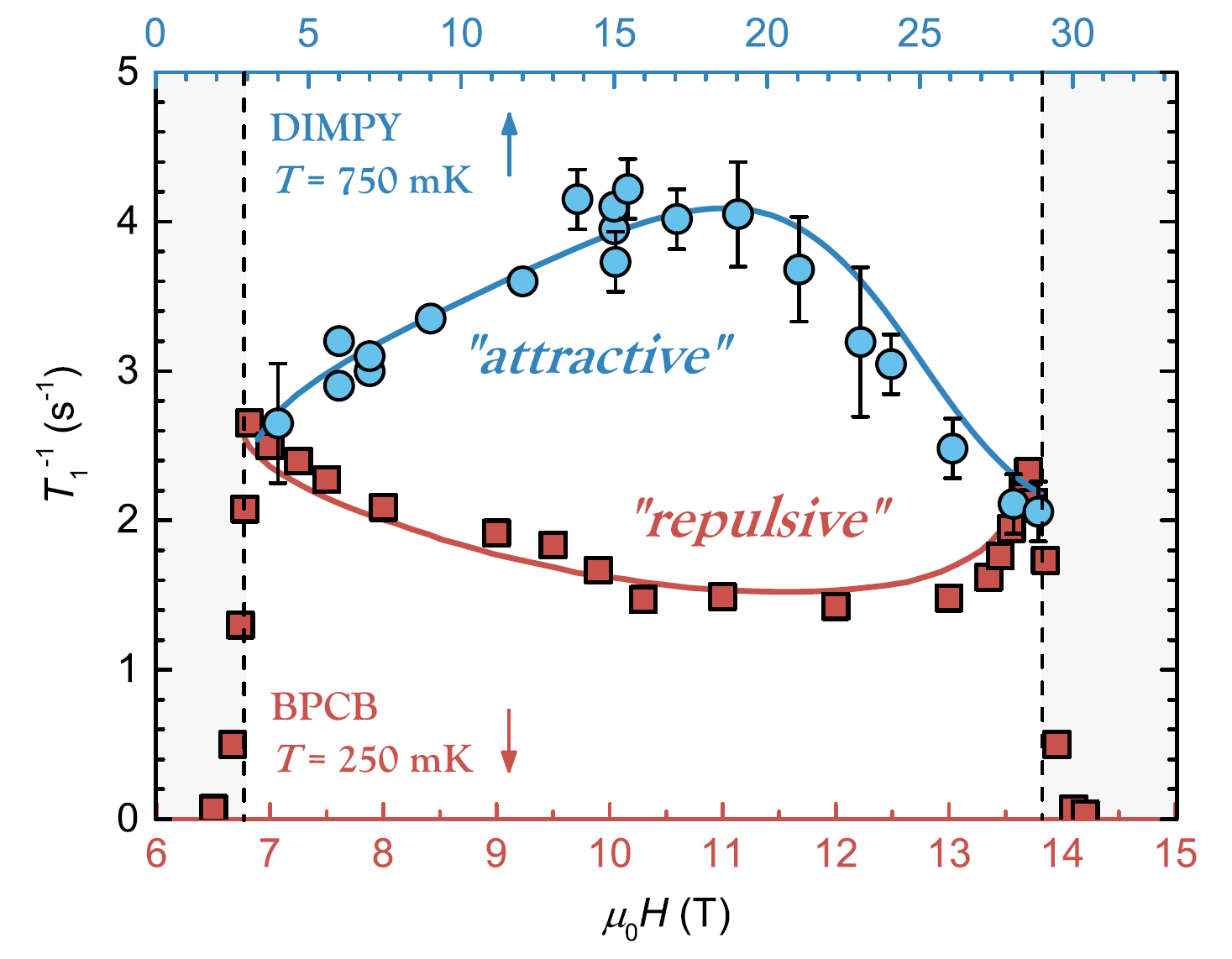NMR, muSR and Moessbauer
Our main experimental tool neutron scattering is a momentum-resolved technique. In magnetic systems it probes temporal correlations between spatial Fourier components of magnetization. Complementary information can be obtained by measuring local correlations between values magnetization in a particular point in space. For this one obviously needs a microscopic local probe with sensitivity on the atomic scale.
One approach to use the nuclei of certain atoms that are part of the material's structure. In Nuclear Magnetic Resonance (NMR) experiments one measures how the precession of nuclear spins is influenced by local fields generated by the magnetic electrons in the system. In our lab we don't have an NMR apparatus, but we are involved in tight collaborations with research groups who specialize in this technique. Not only do we provide samples for experiments, but our students often visit those labs to directly take part in the measurements.
The simplest use of NMR is to measure the local static fields produced by long range magnetic order in the sample. NMR lines are shifted and split, which carries information on the magnitude of the magnetic order parameter and the spin structure. Here are some recent measurements of such 31P NMR line-splitting in Pb2VO(PO4)2 carried out at the LNCMI-CNRS in Grenoble, France. These experiments revealed a new exotic pre-saturation phase in this frustrated quantum ferro-antiferromagnet. For more information see external page F. Landolt, S. Bettler, Z. Yan, S. Gvasaliya, A. Zheludev, S. Mishra, I. Sheikin, S. Krämer, M. Horvatić, A. Gazizulina, and O. Prokhnenko, arXiv:2006.04592 (2020).

NMR can also probe aspects of spin dynamics. The so-called relaxation rate measurements directly probe the local spin correlation function of the electronic spins at some small but finite frequency. It is an invaluable tool for studying critical dynamics. In the example below, we have applied 14N NMR to measure quantum critical fluctuations in the Tomonaga-Luttinger spin liquid phase of the quantum spin ladder material DIMPY. For more details see external page M. Jeong (정민기), D. Schmidiger, H. Mayaffre, M. Klanjšek, C. Berthier, W. Knafo, G. Ballon, B. Vignolle, S. Krämer, A. Zheludev, and M. Horvatić,Phys. Rev. Lett. 117, 106402 (2016).

Another beautiful technique that uses nuclei as local probes for magnetism is Mössbauer spectroscopy. The idea is to measure the frequency shift of gamma quanta emitted by a radioactive nucleus present in the sample. That shift carries information about the local environment and magnetic field at the nucleus site. Unfortunately, this method can only be applied in very few special cases. We were involved in only one such experiment. The measurement revealed a microscopic coexistence of spin glass and long range antiferromagnetic order in the compound PbFe1/2Nb1/2O3. Some 57Fe-Mössbauer spectra are shown below, but for more details see external page Sh. Chillal, M. Thede, F.J. Litterst, S.N. Gvasaliya, T.A. Shaplygina, S.G. Lushnikov, A. Zheludev, Phys. Rev. B 87, 220403(R) (2013).

What if there are no convenient nuclei in the material or if they are all in the wrong positions? The solution is to artificially implant a local probe in the sample. For this purpose one uses positively charged muons. Their spin precesses in the local magnetic field and is deduced from the direction in which a positron is emitted when the muon decays a few microseconds later. The technique is called muSR. There are only four installations in the world that produce muons for such experiments. We are very fortunate to have one right next door, at external page Paul Scherrer Institut where we are quite regular users. muSR is particularly good at detecting very small magnetic moments. In the example below we measure muon precession to understand the chemical composition dependence of magnetic order in the random-bond quantum spin chain material BaCu2(Si1−xGex)2O7, looking for the so-called random-singlet phase. For more details see external page M. Thede, T. Haku, T. Masuda, C. Baines, E. Pomjakushina, G. Dhalenne, A. Revcolevschi, E. Morenzoni, A. Zheludev, Inhomogeneous ordering in weakly coupled Heisenberg S=1/2 chains with random bonds, Phys. Rev. B 90, 144407 (2014).
